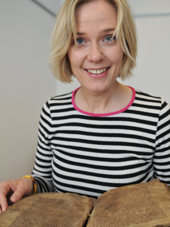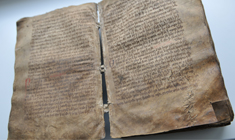Saucy poems, supernatural creatures, explicit violence and emotional outbursts are an integral part of the Icelandic sagas, says assistant professor Annette Lassen from the Department of Scandinavian Research at the University of Copenhagen, but Danish translator N.M. Petersen, whose translations have been the standard for the past 170 years, left passages out and even ignored entire stories because they did not conform to contemporary Romantic norms.
More violence? These stories have drunked pre-schoolers chopping people in half. But violence is not the only thing prevalent in the sagas - the protagonists in the new Danish translations will be complex, literary figures with emotions and the ability to express them, often in quite poetic forms.

Annette Lassen, editor of the new Njal's saga translations. Credit: University of Copenhagen
"Our new translations of the 40 sagas and 54 shorter tales, some of which have never been translated before, give the readers a completely different reading experience by presenting the sagas as they were written 700-800 years ago, complete with rude language, fantastical beasts and events – not as polite and edifying stories," says Lassen.
This means that the saga protagonists we meet in the new Danish translations will be complex, literary figures with emotions and the ability to express them, often in quite poetic forms.
During the Romantic Period, when the sagas were first translated by N.M. Petersen, they were seen primarily as historiography – although a modern audience would never think of them as documents of history.
"Even though we do not treat the sagas as historiography today, they are actually the only written sources we have of a number of seminal events in Nordic history – such as Erik the Red’s Saga about the exploration of North America, which was called Vinland by the explorers. But more importantly, perhaps, the sagas are a crucial component of Danish and Nordic cultural history, and it would be difficult to understand either without having some idea of the sagas’ influence on them," Lassen points out.
"Many sagas are actually tragedies about unrequited love, and the heroes often express their feelings in verse, but these lyrical passages were expurgated from the old translations. We restore these passages now and thus “give birth” to a different version of the saga hero than the brutal, tight-lipped ones we have come to expect when we read books or see films where Vikings play a role – such as actor Mads Mikkelsen’s character in Valhalla Rising from 2009."
Part of the Western canon
The influence of the Icelandic sagas is not restricted to Scandinavia but is seen around the Western World; J.R.R. Tolkien is one of the most famous admirers of Norse mythology and history, and the "Lord of the Rings" would be inconceivable without the sagas. Another famous British author, Sir Walter Scott, drew heavily on the sagas in his romances.
"The canonical status of the sagas across the Western World is indisputable, but if we want them to remain classics, it is absolutely vital that new generations of readers are able to read them, but the archaic language of the old Danish translations makes them virtually illegible to a young audience.

Njal's saga. Credit: University of Copenhagen
"It is a rule of thumb that classics should be translated every 50 years to keep them fresh and accessible, so it is high time that we get a new Danish version of the sagas – just as the English-speaking world got a modern and up-to-date version with the Complete Sagas of the Icelanders in 1997."
The world’s largest translation project
It is the owner of the Saga Publishing House in Reykjavik, Jóhann Sigurdsson, who has initiated and obtained funding for the coordinated, pan-Nordic translation project in which all Icelandic sagas are translated into modern Danish, Norwegian and Swedish. The project also includes a German translation of the sagas, making it the world’s largest coordinated translation project.
The model for this project is the Complete Sagas of Icelanders, the English translation of the entire saga corpus that was published in 1997 by Leifur Eiriksson Publishing.






Comments